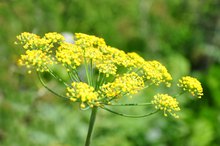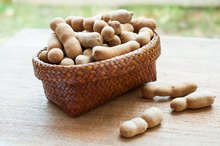Spices High in Purines
Purines are naturally occurring compounds that are present in your cells and in a variety of foods, particularly organ meats. Upon metabolizing, purines break down into uric acid, which in excess can cause gout, kidney stones and kidney failure. Although spices are generally quite low in purines, you may want to avoid a select few that can irritate uric acid levels in the body. If you suffer from high uric acid levels, always consult your physician prior to changing your diet.
Poppy Seeds
Poppy seeds contain the most purines in the spice family -- approximately 170 milligrams per 100 grams. These seeds are primarily used to add flavor or decoration to baked goods, such as breads, bagels, cake and muffins. Both the black and white varieties of poppy seeds should be avoided to limit your purine intake.
Pumpkin Spice
Sources of Laetrile in Food
Learn More
Pumpkin spice has a purine content of 44 milligrams per 100 grams and is relatively safe for occasional to moderate use, depending on your total purine intake of other foods. Unlike traditional pumpkin spice that contains a mix of cloves, cinnamon and nutmeg, dried pumpkin spice comes from drying out pumpkin seeds and grinding them into a fine gradient.
Sesame
Dried sesame contains about 60 milligrams of purine per 100 grams and is not particularly dangerous for high uric acid level sufferers. This item has a longstanding traditional use in many Middle Eastern dishes and was a common condiment. Although sesame does have anti-inflammatory properties helpful in arthritis, gout is specifically triggered by the purine content. Eating sesame in moderation may not cause any aggravation.
- Dried sesame contains about 60 milligrams of purine per 100 grams and is not particularly dangerous for high uric acid level sufferers.
- Although sesame does have anti-inflammatory properties helpful in arthritis, gout is specifically triggered by the purine content.
Related Articles
References
- MedlinePlus: Gout
- “Beating Gout”; Victor Konshin; 2009
- “The Encyclopedia of Nutrition and Good Health”; Robert Ronzio; 2003
- “The Encyclopedia of Healing Foods”; Michael Murray, et al.; 2005
- Benn CL, Dua P, Gurrell R, et al. Physiology of hyperuricemia and urate-lowering treatments. Front Med (Lausanne). 2018;5:160. doi:10.3389/fmed.2018.00160
- George C, Minter DA. Hyperuricemia. [Updated 2019 Jun 4]. In: StatPearls [Internet]. Treasure Island (FL): StatPearls Publishing; 2019 Jan-.
- Ramirez-Sandoval JC, Madero M. Treatment of hyperuricemia in chronic kidney disease. Contrib Nephrol. 2018;192:135-146. doi: 10.1159/000484288
- Wilson FP, Berns JS. Tumor lysis syndrome: new challenges and recent advances. Adv Chronic Kidney Dis. 2014;21(1):18–26. doi:10.1053/j.ackd.2013.07.001
- American Association for Clinical Chemistry. Uric acid. Reviewed May 17, 2017.
- Khanna D, Fitzgerald JD, Khanna PP, et al. 2012 American College of Rheumatology guidelines for management of gout. Part 1: systematic nonpharmacologic and pharmacologic therapeutic approaches to hyperuricemia. Arthritis Care Res (Hoboken). 2012;64:1431–46. doi: 10.1002/acr.21772
- Coburn BW, Bendlin KA, Sayles H, et al. Target serum urate: Do gout patients know their goal? Arthritis Care Res (Hoboken). 2016;68(7):1028-35. doi:10.1002/acr.22785
- Wiederkehr MR, Moe OW. Uric acid nephrolithiasis: a systemic metabolic disorder. Clin Rev Bone Miner Metab. 2011;9(3-4):207–217. doi:10.1007/s12018-011-9106-6
Writer Bio
Skyler White is an avid writer and anthropologist who has written for numerous publications. As a writing professional since 2005, White's areas of interests include lifestyle, business, medicine, forensics, animals and green living. She has a Bachelor of Arts in anthropology from San Francisco State University and a Master of Science in forensic science from Pace University.








